Making a Book
Andrew Wright is an author, illustrator, teacher trainer and story teller. He has published with Oxford University Press, Cambridge University Press and Pearson. As a teacher trainer and story teller he has worked in 55 countries. E-mail: andrew@ili.hu,
www.andrewarticlesandstories.wordpress.com
Estimate at least two lessons for making a book. But take into account that many students will work on their book in their own private time.
Why make a book?
Of course it can be a book or an illustrated story on a website.
Although it takes time it is hugely motivational. The students are not doing something for you to correct! You are helping them to publish their own work in English! Such a fundamental difference!
Books are wonderful because you can exhibit them in the school AND you can go to the school director, show him or her the books and then ask for money to attend SPELT conferences.
Publish student stories for others through: books, posters, websites, plays, videos, audio recordings.
All levels
Elementary students have the delight of seeing their very limited English actually making something special. Advanced students are as challenged in their writing as any other author!
The examples I have chosen range from very young children who made a story but couldn’t write through to very competent teenagers.
Different contributions from different language proficiency levels
- The children: beginners and young. They make a story with me, orally. I write up their story and put it into a book. The children add the illustrations.
- Ditto 1 above but the children add some of their own texts.
- Older students who can write. Having made the story as a class, work in groups or as individuals and write and illustrate the whole book by themselves.
The source of the story
The story might come from their imagination ie as a result of the Class Oral Storymaking. Or it might be a re-telling of an existing story.
An example of a detailed procedure
If they have made a story with the Class Oral Storymaking technique you might very reasonably say, ‘Gosh! That’s a super story! We can’t just lose it! We must make it into a book.
‘Lets make different books in groups. Get together in 3’s or 4’s or 5’s. Here is the zigzag book you are going to have. Its got a cover and 7 pages (can be more). You can work on it together…and decide if you each do two pages or whether one person writes and the others draw.
‘To help you lets divide the story into seven parts and then you will know what to write and draw on each page.’
The class then brainstorm what they think the seven parts might be. You act as their secretary and write on the board for them to copy. If they are elementary you might even write the sentences for them to copy. If they are higher level you can write key words to help them with the story and the language they will need.
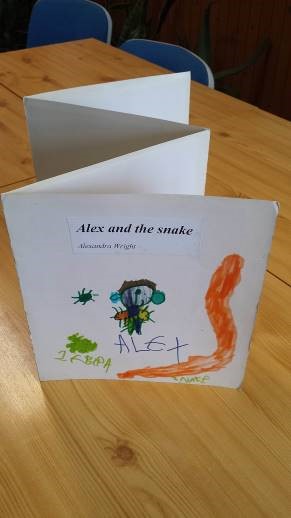
Alex who has autism wrote this 8 page zigzag book when she was about seven. You can see that we worked on it together. Sometimes I typed her sentences and sometimes she wrote her own sentences. For Alex English is her second language.
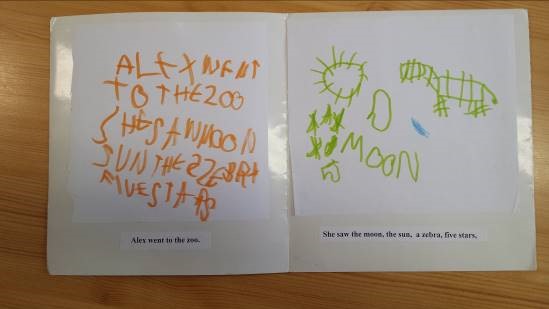
This is an inside double page spread in Alex’s book, showing her writing and mine.
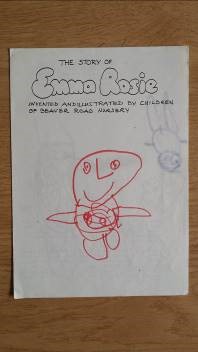
A class of children aged four made this 4 page story about Emma Rosie in their mother tongue. I went home, typed up their story as you see above and below, photocopied enough copies for each member of the class and explained to them that it was their story and their book. They illustrated it…matching their illustration with what they believed to be the text on that page.
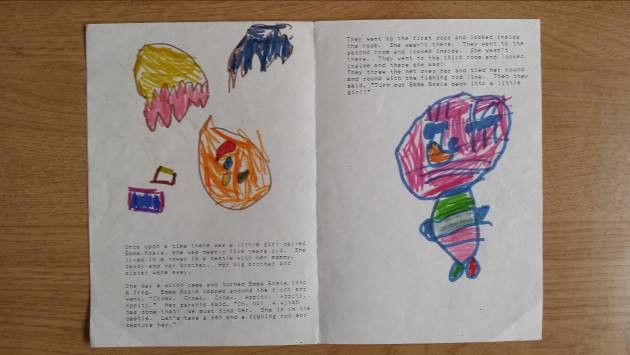
Here is my typing of their text and the illustrations of one of the children.
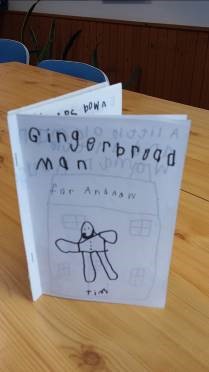
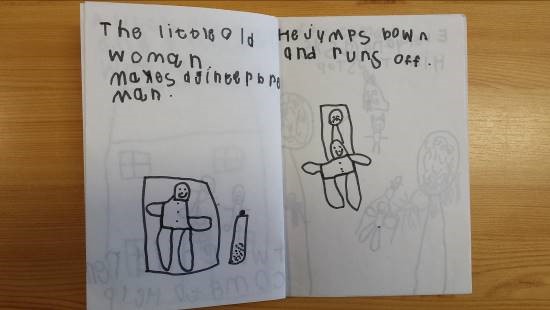
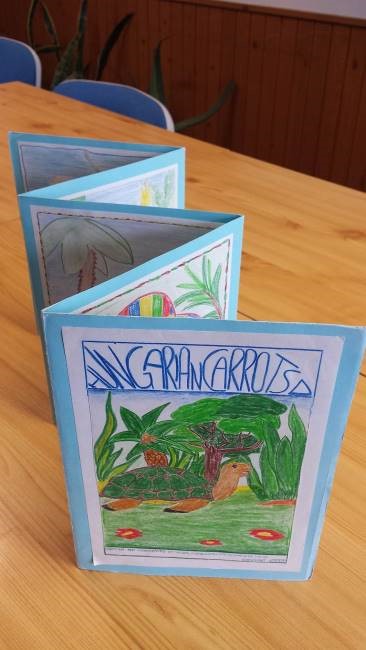
This book by Tim was done entirely by him for me. He was seven and a native speaker of English. Of course it was easier for him because he was writing in his mother tongue. BUT the point is that he chose to make this book in his own time and chose to give it to me! What a treasure!
This is a ten page zigzag book. Each white sheet is A5 and was stuck into the book when the text and illustration were ready. It was made by a group of Austrian teenagers following a class oral story making. Each teenager wrote and illustrated two or three pages. Most of the work was done in their private time and they did it because they loved doing it.
One mother in the town told me that her son was setting his alarm clock early so he could go to school and work with his group on their book before school started!
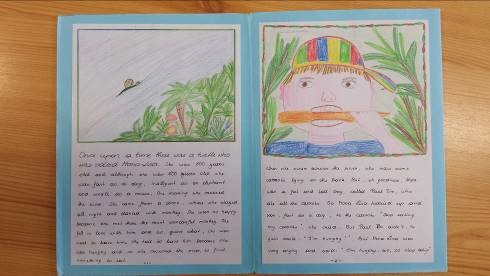
Because they work on separate sheets of A5, it is easy for the whole group to be working at the same time and easy for you to check the language before it is pasted in to the book…if that is what you want to do.
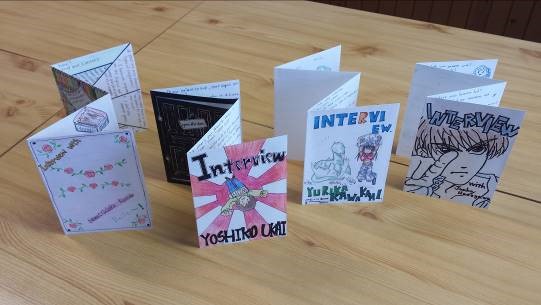
I worked in Chubu Gakuin University in Japan with the students. These were some of the zigzag books they made. Once more they went ‘far beyond the call of duty’ and spent a lot of private time on them.
Book making is relevant to all ages and abilities and your role is to help, support, encourage and unobtrusively, guide. NOT correct and mark! They are publishing in English!
Do you remember the first example above? It was a book made by Alex who has autism. Her mother tongue is Hungarian. English is her second language. She has continued to write stories and she is now 21 years old. Her books are much longer and she has taught herself German. Here is a book of 330 pages written in German! Every page illustrated. Nobody tells her to write stories. Nobody gives her marks or gold stars. She makes books because it matters to her…it matters to human beings to make something useful and interesting. Enable your students to do the same!
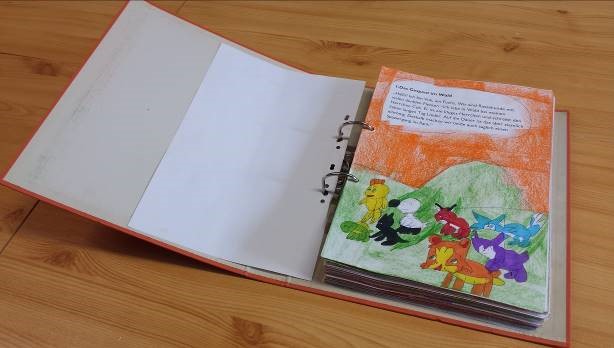
Here is one of her many ‘big’ books! She now writes in Hungarian, in English or in German.
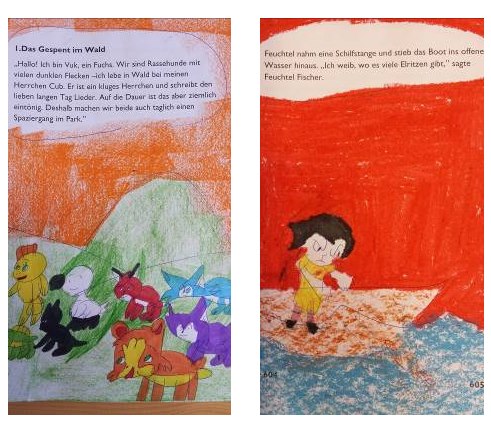
The first page and one of the last pages. Note: she has observed that on double page spreads this is a page number on each page. She has adopted this idea but puts two numbers on one page. So really this is page (about) 300!
Biggest tip of all!Be joyful if your cup is half full that means it is not half empty! Enjoy it! We only live once! Share your joy with them! Hop about and shout Yippee!...or however you express such things. |
Further reading
David Heathfield (2014) Storytelling with our Students. London. Delta
A book for developing as a classroom storyteller. It features over 40 folk tales from around the world, each one of them illustrating a different technique or activity.
Andrew Wright (Sec Ed 2004) Storytelling with Children Oxford University Press.
This book contains 32 stories and lesson plans and 92 different activities you can do with any story. Children and teenagers.
Andrew Wright (1997) Creating Stories with Children. Oxford University Press.
Lots of ways of helping children to make stories and story books. Children and teenagers.
Andrew Wright and David A. Hill. (2008) Writing Stories. Helbling Languages.
More suitable for teenagers
Please check the Methodology and Language for Kindergarten course at Pilgrims website.
Please check the Methodology and Language for Primary course at Pilgrims website.
Please check the Creative Methodology for the Classroom course at Pilgrims website
Making a Book
Andrew Wright, HungaryFive Thoughts about Teaching Children
Lucy Crichton, Brazil